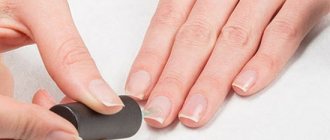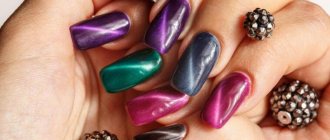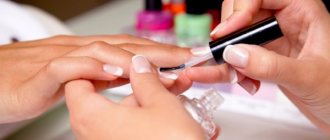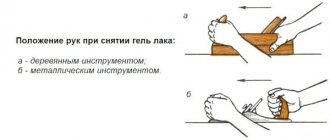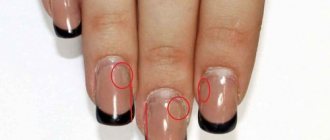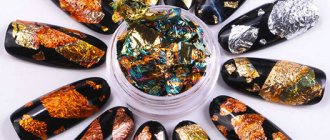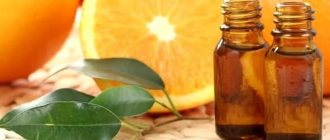Strengthening nails with gel is necessary if they are weakened, thin, peeling or breaking. The procedure is also indicated for long, highly flexible plates. Strengthening is carried out not only with extension products, but also with hard bases, acrylic compounds, the same powders, biogels, including camouflage ones.
One of the selected cosmetic preparations is applied to oil-free nails, coated with a primer, and polymerized. Unevenness should be removed with a file and a buff. And on top the strengthening agent is covered with gel polish or only with a transparent top. After all, many of them also give a beautiful natural shade to your nails, without the need to paint them.
Strengthening nails with gel: what is needed for the procedure

Strengthening nails with gel is only possible if you have a certain set of products and tools:
- lamps for coating polymerization,
- nail files,
- soft buff
- orange stick,
- clinser,
- primer,
- degreaser,
- lint-free wipes,
- brushes for applying strengthening composition,
- the means for imparting rigidity to the plates.
The list of what is needed to strengthen nails with gel depends on their general appearance and condition. Before starting the procedure, you must perform a hygienic manicure. Then the list of tools will expand; you should add cuticle scissors, an applicator with a silicone tip, or a pusher. After all, in essence, strengthening nails with gel is a procedure that precedes the application of a decorative coating for longer wearing. That is, doing a manicure after using a product that gives your nails strength and smoothness is pointless.
Why is the procedure useful?
Natural nails are prone to brittleness and flaking, so manicurists recommend strengthening them with gel.
This procedure is useful for the following reasons:
- The nail plate does not deteriorate; on the contrary, under the influence of the gel it thickens and becomes even.
- Not only the nails, but also the cuticles receive care, since the trimming manicure procedure is performed less frequently.
- Nails look natural, strengthening with gel preserves the natural shape of the plate.
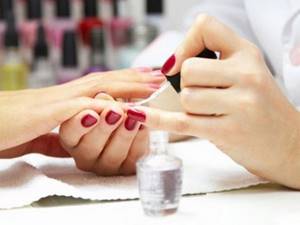
This procedure can be done both in the salon and at home, if you have the necessary knowledge and tools (experience will come with time).
Strengthening nails with gel under gel polish: options for how to strengthen them
Strengthening nails with gel under gel polish is required if they are thin, excessively flexible, or flaking. If the surface of the plates is too oily or damp, the procedure will also prolong the wearing of the color coating. Today the following types of nail strengthening with gel polish are known:
- Acrylic composition, also known as acrylic, hybrid gel or polygel. This viscous product with synthetic components is pink, beige or completely transparent. It does not level out on the surface on its own, but it does not flow onto the skin. The product is easy to file off after drying if the layer is too thick.
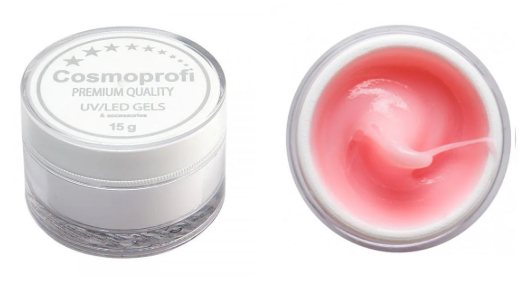
Acrylatic Cosmoprofi (hybrid of gel and acrylic) Acrylatic Pink
- Acrylic Powder. This is a brilliant, finely ground powder of the same nature as the previous remedy. It is easier to strengthen nails with gel polish than with liquid acrylic, especially since there are several ways to apply powder evenly. It also comes in color and transparent.
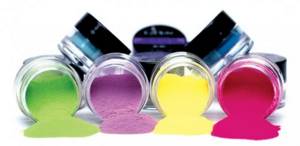
Colored acrylic powder
- Biogel. This is a colorless or tinted, rather thick liquid containing synthetic polymers, calcium, vitamins, and proteins. It not only makes nails tough, eliminating brittleness, but also nourishes them. The product has a thinner consistency than acrylic, so it is easier to apply.
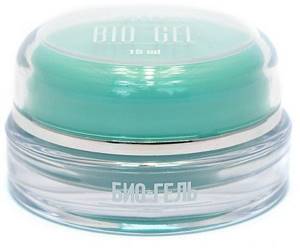
Covering natural nails with this gel without extensions is technically comparable to using a rubber base. But the strengthening effect of a product with natural ingredients is, of course, more noticeable.
- Single-phase gel. This composition is intended for extensions, but can also be used for natural nails of any length to make them stronger. It does not require a base or top coat, which greatly simplifies the work. But at the same time, you don’t have to be afraid of peelings; the manicure lasts a long time. The compositions also come with a tint, that is, they can be used without colored varnish.

- Other types of extension gel. They can be transparent or tinted, two- and three-phase. The products are easy to apply and have the consistency of a thick base or top.
Acrylic gel
Acrylic gel can be an ideal composition to make nail plates stronger if used correctly:
- First, the surfaces are treated with the hard side of the buff.
- They need to be degreased.

- First, apply a thin layer of primer to clean nails, air dry it for a few seconds until it evaporates completely.
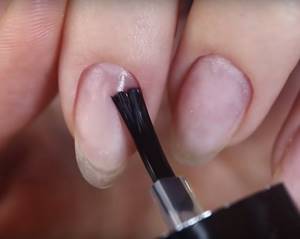
- Then you need to apply a liquid base with good adhesive properties not only to the entire plate, but also to the end parts.
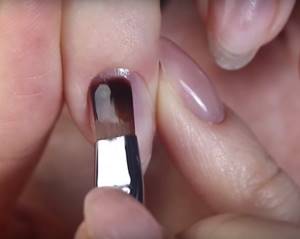
- This layer is dried in a lamp.
- The brush that will be used to pick up and apply the acrylic is lightly moistened in a cleanser (you can drip it onto a cotton pad).
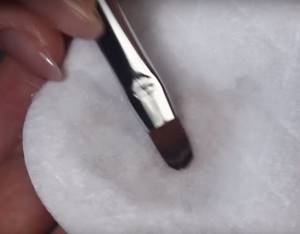
- The required amount of composition is scooped out of the jar with it or a spatula and a portion is applied to the nail.
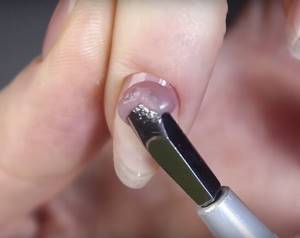
- With a brush, it is kneaded over the plate so as not to disturb its natural architecture, that is, thinning the layer near the cuticle and side ridges.
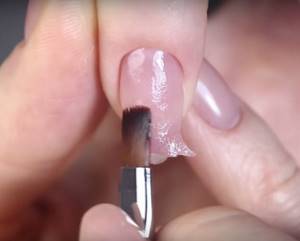
- The pile of the tool is moistened a little more with a cleaner and the acrylic is smoothed out, removing the glare.
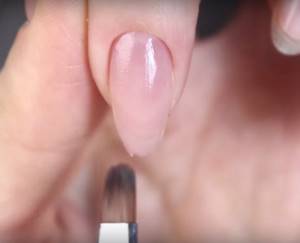
- If there is excess product on the end, remove it with a brush or pusher while it is wet.
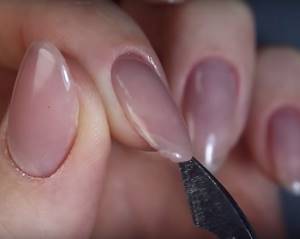
- The hand should be placed in a drying lamp.
- The acrylic remaining at the ends is cut off, it also needs to be removed from under the nails.
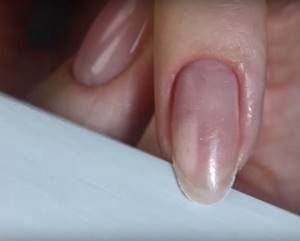
Strengthening with a solid gel can be done under polymerizing colored varnish or left as the main coating of a natural shade, adding gloss with a top coat. In the first case, the dried acrylic needs to be removed from stickiness, then treat the nails with a buff and wipe off dust with a degreaser. After that, they are painted, the flower bed is polymerized and a top coat is applied. The last product also needs to be dried.
Strengthening your nails before gel polish will help avoid not only brittleness and cracks, but also eliminate peeling and chipping. In this case, the plates should not look thick. The layer of the strengthening agent must be no more than 0.5 mm, otherwise it may not dry out.
Acrylic powder is an excellent tool for strengthening natural nails.
Another commonly used product for strengthening natural nails is acrylic powder, which is quite simple to use:
- After the manicure, the nails are degreased.
- Then one of the plates is covered with a base, not reaching a couple of millimeters to the cuticle.
- This finger is dipped into a jar of acrylic powder 2-3 times so that the border of the product does not reach the base line.
- Excess powder is shaken off by lowering your hand down and tapping the joint with the applicator.
- The nail must be dried for 30 seconds.
- It is treated with a brush to remove excess grains of powder.
- Next comes the application of a leveling base layer, which is also dried for 30 seconds.
After this, you can paint your nails with a flower garden as usual.
Other methods using powder
There are other ways to strengthen nails with gel polish powder:
- Spray it on your nails. The base is applied as in the first case, with a layer of medium thickness. Then acrylic powder is poured onto the surface of the nail in several portions. The finger is placed in the lamp for 30 seconds, after which the plate is treated with a brush. All previous steps can be repeated with each nail 2 more times to strengthen them more reliably. And you can design with gel polish.
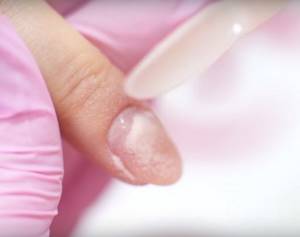
- Mixing acrylic powder and base. A drop of the liquid product is placed on the palette, and a little powder is poured next to it. The components are mixed with a stick until a paste-like composition is obtained. Place a portion on the nail and work with it as with ready-made acrylic.

With gel under gel polish
Strengthening nails with gel under gel is also easy, in several stages:
- Apply primer, air dry.
- Using a special base for a strengthening agent, polymerization.
- Apply the gel first in a thin layer, then “wet” in a thicker layer using the leveling technique.
- Turn your hand over to spread the product.
- Drying in a lamp with a decrease in its power setting.
- Degreasing and coating with colored gel polish, top coat, sequential polymerization of each layer.
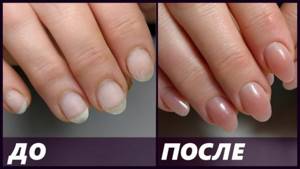
Biogel
Biogel not only makes nails harder so that the manicure lasts longer, but also treats them, allowing them to grow their own length. After all, these products contain proteins, calcium, vitamins and fewer aggressive components. Another advantage is the variety of colors of the product, that is, it can be used as a coating. The strengthening procedure looks like this:
- Prepared nails are degreased and an acid-free primer is applied to them, covering the ends as well.
- The product is air dried for 1 minute.
- Next, apply the biogel, applying a thin layer, not forgetting about the end edges.
- A second layer of strengthening agent is applied to the wet coating, simultaneously leveling the plates.
- After drying, you can paint your nails with colored gel polish, then use a finishing agent, they are polymerized one by one.
Some masters use a base before biogel. But this remedy is needed for especially problematic nails, on which the coating hardly sticks.
Watch the video about three methods of applying biogel:
Single phase gel
Single-phase gel for strengthening weakened nail plates is applied in the following sequence:
- They are properly prepared, and after a hygienic manicure they are wiped with a degreaser.
- Then apply the first thin layer, spreading it over the entire plate, do not dry.
- A larger volume of product is placed on this base and leveled so that the coating is denser.
- All that remains is to dry it in a lamp.

Then you can cover your nails with colored gel polish or do without it. But in any case, a finishing agent is applied on top.
Should I use primer and dehydrator with polygel?
It is recommended to use the dehydrator only on very wet nails. Because The dehydrator removes moisture deeply enough; it cannot be used for dry nails. Primer from Lovely is acid-free, but nevertheless, even it should not be used recklessly. It is recommended to be used for clients whose nails are prone to peeling (taking antibiotics, hormonal and pre-medicine medications, health problems, etc.). You can apply the primer not to the entire nail, but to a third of the nail and the end. Important! Apply once, in a thin layer, avoiding contact with the skin. The dehydrator and primer are air dried.
Which gel is suitable for strengthening nails?
Gel for strengthening nails is chosen according to their condition and the nature of the problems:
- if they are uneven, with damage in the form of pits due to the tearing off of the old coating, or “twisted”, it is better to use acrylics;
- for thin, brittle nails due to a lack of vitamins, a bio-composition is more suitable as a nail hardener under the gel;
- if the coating simply doesn’t wear well and flies off quickly, you can use a single-phase product for the flower garden;
- For soft, bendable plates, strengthening nails with extension gel is more suitable, but acrylic powder will also provide a good effect;
- for long lengths, it is also worth choosing one of the two previous products.
It is difficult to say which gel for strengthening nails is better, since everything is individual. You should pay attention to the following brands:
- biogels from TNL, Planet Nail, Irisk, Nail Professional;
- regular extension compositions SuperNail, LiaNail, NSI, Dance Legend;
- acrylics Irisk, Patrisa Nail, Cosmoprofi, Global Fashion, Tertio;
- acrylic powders Harmony, Kodi, Irisk, Entity (the main thing here is fine grinding).
All of the listed products have different consistencies and are also applied differently - some are easier, others require great care. But they are very persistent. And gel polish with strengthening is the use of any of the proposed compositions, which is paid separately from nail art masters according to the price list.
Contraindications
No matter how effective the gel is, there are a number of contraindications, due to which you need to wait a little with strengthening. In these cases, gel strengthening can be harmful.
- Fungal, bacterial or viral infection of the nail plate and skin of the hands
- Hematomas under the nail
- Allergic reaction to the gel. In this case, you can resort to using biogel, which is a hypoallergenic drug.
There are no side effects from using the gel.
The positive aspects of this procedure are quite obvious. The gel will help protect your nails and speed up their regrowth process. And the use of colored gels and various design elements will help create a unique manicure.
Liked? Share with your friends!
Strengthening nails with a base
Strengthening nails with a base is necessary for long lengths, as well as a thin plate, if there are no other problems. To do this, use a rigid substrate, that is, a product designated strong:
- Nails ready for coating are degreased.
- Then they are covered with a thin layer of plastic base and dried.
- Now it’s the turn of that very hard base, which is initially applied thinly, and then in a drop and leveled.
- This layer also needs to be dried.
- This is followed by the application of gel polish, top coat and polymerization of each product.
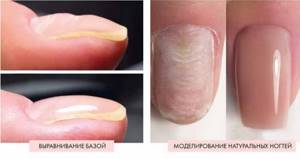
After the 4th stage, long nails should be checked for strength by pressing on the free edge. If they have not acquired sufficient rigidity and are still bending, you can apply an additional layer of strong base.
Rules for applying the gel
The gel is applied in three stages.
- The first layer, the base layer, is very thin and dries quickly, only 30 seconds. under an ultraviolet lamp.
- The second layer will become the main one, so it is applied tightly, from the edge of the nail to the cuticle. Drying is carried out within 3 minutes. If correction is required, it is carried out with a buff and a nail file.
- Finish - the gel is also applied in a thin layer, but dries for 3 minutes. If it is sticky after drying, you can remove the top film with an acetone-free remover.
You can apply layers using different compositions, but the “from one jar” option is allowed, observing the technology and drying time.
Applying the base
You can clarify the questions from the video and attached photo. Careful implementation of all manipulations in stages will gradually give the necessary skill and excellent results in the form of well-groomed nails, as well as possible additional income if you want to receive clients and perform gel coating at home.
How to strengthen nails with gel: what to do step by step at home
You can strengthen your nails with gel at home if you follow the procedure step by step:
- Get a manicure, either with a machine or using a nail file, orange stick, remover, nippers or cuticle scissors.
- Treat the surface of the plates with a buff to remove shine.
- Wipe them with degreaser.
- Strengthening nails with gel is not complete without using a primer.
- A minute or two after this, the first thin layer of gel is applied.
- Take a new portion of the product and distribute it over the plate, making the coating more dense.
- Send your hand into the lamp.

Applying three-phase gel to nails to strengthen should be almost the same, but from the 5th step the sequence is as follows:
- base,
- drying,
- dense layer of gel,
- another drying
- removing uneven nail surfaces with a file,
- finishing coating,
- drying.
To ensure that the manicure does not have bumps, it is important to apply the gel correctly to strengthen the nails. The first layer is laid in three long strokes - along the side rollers and in the center of the plate. Then the drop is placed on the highest point of the nail and stretched with zigzag movements over the entire surface. The finger should be turned upside down and the product should be helped to lie evenly with a thin brush. Gel for thickening nails under gel polish should not be applied under the cuticle, since at the base they are already quite strong.
Materials and tools
In order to carry out the strengthening procedure efficiently, it is recommended to stock up on the necessary tools and materials.
To prepare your nails and perform a manicure you will need the following:
- file, buff (help to give the desired shape, level the surface of the plates);
- orange or metal stick (pushes back the cuticle);
- remover (used for unedged manicure) or nippers (for classic manicure).

To apply the gel coating, you must purchase the following:
- only gel (if it is single-phase), gel+base+finish (if the product is three-phase) or biogel;
- primer to remove excess oil (acid-free for normal nails, acidic for wet nails);
- dense synthetic brush (used to apply the material);
- UV lamp (to dry each layer).
Design tools are chosen taking into account what is planned: it can be gel polish, rubbing, decorative elements, glitter.
Shellac with gel strengthening: how to do it, the better
Shellac with gel strengthening is also used for problem nails; this extends the time of wearing a manicure to 2 weeks. Of course, the coating period cannot be compared with gel polish, but chipping and breaking of plates are excluded.
You can strengthen your nails with shellac gel in several stages:
- Coating with primer.
- Applying the base composition under the gel or a good regular base.
- Using a strengthening agent and leveling the plates with it.
- Degreasing surfaces.
- Shellac coating.
- Applying top.
All products used, except the primer, are dried in a lamp. To prevent the strengthening composition from spreading, it is worth polymerizing it on each nail separately.
The best way to strengthen your nails using shellac is to look at their condition. But, given the property of a colored coating of this type to dry out the plate, for weakened and thin ones the most suitable remedy is biogel. If nails break or peel, acrylics, extension gel and powder can be successfully used.
Causes of fragility
Before moving on to strengthening natural nails, you need to clearly understand that they are not brittle just like that. Nails can be considered one of the main indicators of human health, and their condition can determine more than 20 diseases before symptoms appear. Among the main reasons why nails break are the following:
- Incorrect or too frequent use of varnishes and polish removers lead to brittleness.
- Contact with household chemicals without gloves
- Harmful effects of chemicals that a person encounters in certain areas of professional activity. These can be burns from acids or alkalis.
- Sudden temperature changes. If you do not protect your hands from the cold by wearing mittens or gloves, your nails will dry out, become thin and brittle.
- Incorrect care. Avoid using clippers, which can damage the nail plate. Use special files that will allow you to remove excess length and not harm the nail.
- Long stay in the pool. Water with bleach dissolved in it negatively affects the health of nails.
- Lack of vitamins and minerals. The lack of calcium, selenium, zinc, silicon, iron and vitamins A, E, and D has a particularly acute effect on strength.
Gel nail coating without extensions: step-by-step instructions
Step-by-step instructions for covering nails with gel without extensions include sequential use:
- degreaser,
- primer,
- bases,
- the most strengthening agent in a thin layer,
- a denser layer of extension gel,
- clinser,
- files,
- buffa,
- brushes,
- degreaser again,
- gel polish,
- top.
All products, except degreaser, primer and cleaner, are dried in a lamp. As a rule, the dried strengthening agent must be filed down to remove the resulting irregularities. And then the surfaces of the plates are also treated with a buff.
Design ideas
Design when strengthening nails with gel does not necessarily imply the use of a flower garden, because these products come in shades. Therefore, you can simply apply a glossy or matte top coat on top, and you will get a nude manicure. If you highlight the free edge with white and outline the “smile”, it will be a French jacket. And when marking the holes - a lunar manicure.
In general, you can come up with many designs with extension gel:
- paint 2 nails on your hand in beige or pink tones (darker than the shade of the gel) and make graphic designs on them in black and red;
- choose a dark-colored varnish (burgundy, emerald, chocolate, purple) and make tracks from rhinestones or laid out foil on 1-2 plates;
- cover the strengthening camouflage gel with a top coat and make monograms on it with white paint on 1-2 fingers;
- make stretch marks with glitter without using a flower bed using a beige or pinkish strengthening gel.
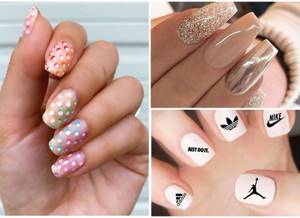
comparison table
We have organized a table of comparative characteristics of all previously presented products.
| Name of the product | Country of Origin | Volume (ml) | Drying time (min) | Cost, rub.) |
| EMI Easy One Gal | Russia | 15 | 2 | 200 – 300 |
| Cover Peach | Russia | 7.5 | 3-4 | 100 – 150 |
| RuNail | Russia | 10 | 4 | 200 – 250 |
| Nail Professional | USA | 15 | 2-3 | 200 – 270 |
| TNL CAMOUFLAGE PINK | USA | 10 | 2 | 300 – 350 |
| Planet Nails Bio Gel Sculpting | South Korea | 15 | 3 | 150 – 250 |
| IRISK CLASSIC CLEAR | USA | 5 | 4 | 400 – 550 |
Strengthening nails in the salon - what is it?
Strengthening nails in the salon means using extension gel, acrylic, powder or biogel under a colored coating, but not only. There are also procedures that have a therapeutic effect:
- Lamination. Includes preliminary preparation, that is, hygienic manicure, hand massage. Then vitamin serums and oil extract are rubbed into the nails. They are coated on top with a nourishing composition in the form of varnish so that the beneficial substances penetrate into the thickness of the plates and are not washed off. It also serves as protection from external influences. And on top of the laminating composition you can apply gel polish.
- Sealing. The procedure is similar to lamination in that nutrients are also rubbed into the nails. These are oils, waxes, vitamins, mineral pastes. They restore the legs and form a protective film on them. But design is not done with gel polishes after sealing.
- Hot manicure. This is a hand bath with herbal, oily vitamin solutions, creams, serums. A constant temperature is maintained in the container during the procedure, which enhances the effect of beneficial substances. After this, you can make a color coating.
- SPA manicure. This is a complex procedure that includes hygienic nail treatment, scrubbing, baths, and massage. The effect is directed not only to the nails, but also to the hands.
- Paraffin therapy. The substance is melted in a special bath, the hands are prepared by scrubbing and massage. Oil, mask or cream is applied to them and to the nails. Hands are dipped into melted paraffin three times, allowed to dry a little, and the hands are wrapped in polyethylene and thicker fabric. After 20 minutes everything is removed. Hands are washed and cream is applied.
Strengthening compounds will help extend the wearing of the design for up to 3 weeks, after which correction is needed. Otherwise, the problems that caused the need for their use will worsen. And in order for the nail-strengthening composition to lay more evenly, you need a high-quality hygienic manicure.
How to remove polygel?
The polygel is easily cut off using hardware or dissolution.
To speed up removal, it is recommended to cut off the volume a little. For gentle removal, use good quality liquids, such as remover from LOVELY. It will take 15-20 minutes and the coating will be softened, you can remove it in a way convenient for you. With the correct use of all materials, the nails will be in their original form.
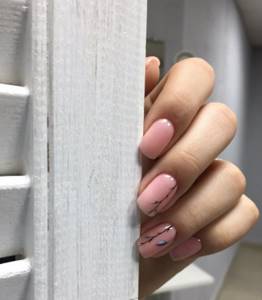
Strengthening nails with a certain skill takes up to 30 minutes. We wish you good luck!
Features of care
Proper care consists of daily cosmetic procedures: nutrition, giving up bad habits, protection. When the nail plate is deformed and thinned, special care is required. You can strengthen weakened nails using gel bases.
Benefits of strengthening nails:
- leveling the surface of the nail plate;
- care not only for the nail, but also for the cuticle;
- low cost compared to classic extensions;
- possibility of independent implementation.
Disadvantages include:
- the need for correction when a boundary appears between the natural nail and the coating, usually once every 2-3 weeks;
- The duration of the procedure, the work takes on average 1-2 hours.
What types of coatings are there? There are 2 types of coatings: standard gel and biogel.
Using biogel is a simpler procedure. It does not require cutting down natural nails to apply it. The composition is applied in a thin layer and can be easily removed. However, the coating is short-lived and easily deformed under the influence of negative factors.
With the help of the gel you can not only strengthen, but also increase any length. Nails become harder, correction is performed without removing the old material. However, before applying the gel, you need to wash down your nails. The final thickness is greater, resulting in loss of elasticity and increased susceptibility to chipping and cracking. Removal is carried out by filing, which can injure the nail plate.
At home
To create a smooth surface, you can use gel extensions. It strengthens and creates a coating for decorative designs. In addition, it protects the manicure from mechanical damage. Before applying the gel, you need to sand the nail plate with a file and polish it with a buff.
To strengthen the nail plates with gel after repeated extensions, you can use a similar product - biogel. It contains proteins and vitamins that heal and stimulate nail growth.
Both tools are suitable for independent use, but financial investments will be required to purchase materials and equipment and hone execution skills.
Important! For beginners, it is recommended to undergo several procedures under the supervision of a specialist.
In the cabin
In a beauty salon, a specialist will strengthen the nail plate, adjust its shape, and carry out hygiene measures under aseptic conditions. Using professional brands of products, he will build up and fix the weakened nail plate.
Note! The gel is effective in the treatment of onychocryptosis, as a strengthener of the shape of an ingrown nail.
A visit to the salon allows you to get the desired result as quickly and comfortably as possible.

Salon care
What do you need
Everything you need to carry out the procedure for strengthening the nail surface can be purchased in specialized stores. Thanks to this, work can be carried out at home. To begin with, you will have to spend a large amount, but in the future it will pay off. You should buy quality products, even though they cost more. Poor quality material will only damage your nails.
Tools and materials
The first thing to prepare is the gel itself. To perform a helium manicure you need to purchase:
- sticks (metal or orange) for moving the cuticle;
- nail file, buff, polishing the nail surface, giving them the desired configuration;
- cuticle remover for unedged manicure;
- nippers intended for trimming manicure;
- primers that remove excess moisture - acid-free or acidic for normal or wet nails, respectively;
- synthetic brush for applying polymer;
- ultraviolet lamp for drying the material;
- cleaners that degrease the nail surface and remove the sticky layer;
- products for nail decoration (varnishes, rhinestones, sparkles);
- cotton pads, lint-free wipes.
Acrylic powder: types and techniques of application
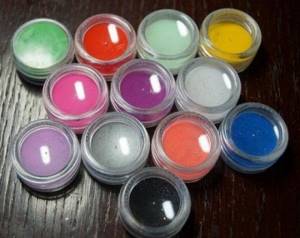
Before purchasing materials and tools, you need to make sure the quality of the product. It is recommended to purchase products from trusted brands, based on user reviews.

Gel selection
When applying the polymer, three layers are formed: base, modeling, finishing. Each of them has its own functions. The base is the base on which subsequent layers are applied. Modeling – forms the nail plate, is responsible for the strength of the material. Finish – designed to protect against negative external factors. Therefore, special attention must be paid to the choice of material.
Getting beautiful, healthy nails largely depends on the quality of the material. There are several types of gels:
- single-phase;
- two-phase;
- three-phase;
- biogels.
The “phase” of the base indicates the number of polymer layers formed.
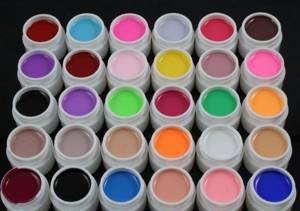
Single-phase gels
It is better to use a single-phase product for beginners who are practicing helium treatment on their own for the first time. It is a mixture that includes all three polymer layers. The liquid consistency makes it easier to distribute the substance over the nail plate. In addition, the load on the natural nail is not so significant, since the single-phase layer is thin. Due to its low density, the nail plate “breathes” and does not dry out. The advantages of the system include saving money and time.
But the single-phase product has its drawbacks. Low viscosity makes it difficult to form the apex (the point where the greatest thickness of the plate is concentrated). A single-phase product does not have a protective layer, so the service life of such nails is shorter. A single-phase polymer is not suitable for those who want to decorate the nail surface with three-dimensional figures or stickers, since it does not contain a sticky layer.
If there is an urgent need to attend a festive event and you need to quickly get a beautiful manicure, a single-phase option will be a good solution in this situation. Otherwise, it is better to use another material.
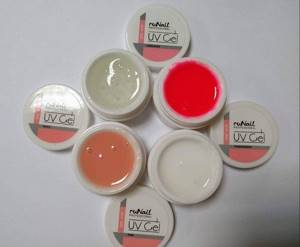
Biphasic gels
The two-phase polymer option includes 2 products. The first contains the base layer, and the second jar contains the modeling layer. The structure of this layer is more viscous than in a single-phase system, so it is easier to model the shape of the plate. The application of each layer is alternated with drying.
Nail baths for growth and strengthening, with salt, iodine and other recipes
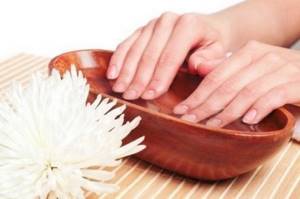
The disadvantage of this system is that the protective coating is a gel that is not intended for this purpose.
Three-phase gels
The most suitable for treating nails is a three-phase system. The set consists of a base product, a structural layer and a protective coating.
In this case, the modeling substance may have a different composition:
- imitating the surface of natural nails;
- colorless;
- pigmentary.
Each of the polymer layers performs its own function. The task of the base coating is to ensure reliable adhesion of the horn plate to the gel. The thick consistency of the material allows you to give the plates different shapes. The top protects against chips and damage and ensures the safety of the material.
Although the three-phase product takes longer to apply, it has many advantages:
- adhesion between the material and the nail surface is much stronger;
- the thickness at the end of the plate can prevent breakage;
- the coating lasts a long time;
- It is possible to decorate the horny surface with any design.
The procedure is labor-intensive and requires a large investment of material resources, but the quality of the coating is much higher than when using a one- and two-phase system.
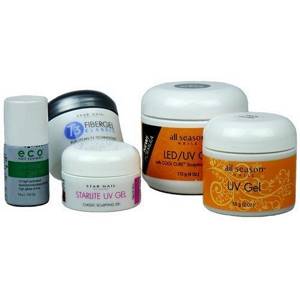
Biogel
Biogel is often used to strengthen nails. This is a polymer that contains rubber resin. Very often it is used to improve the health of nail plates damaged after poor-quality extensions.
The material is very elastic, so it is not used to lengthen the plate. With its help, you can only extend the corners to give shape or restore the plate.
The advantages of this tool include:
- environmental safety;
- no allergic reaction;
- natural looking nails;
- protection of nails from damage;
- strength and durability;
- does not require filing of the nail plate.
Biogel is an excellent option for women with a thin horny plate. It will help heal the nails, strengthen them, and give them rigidity. Biogel can be coated with any varnish.
